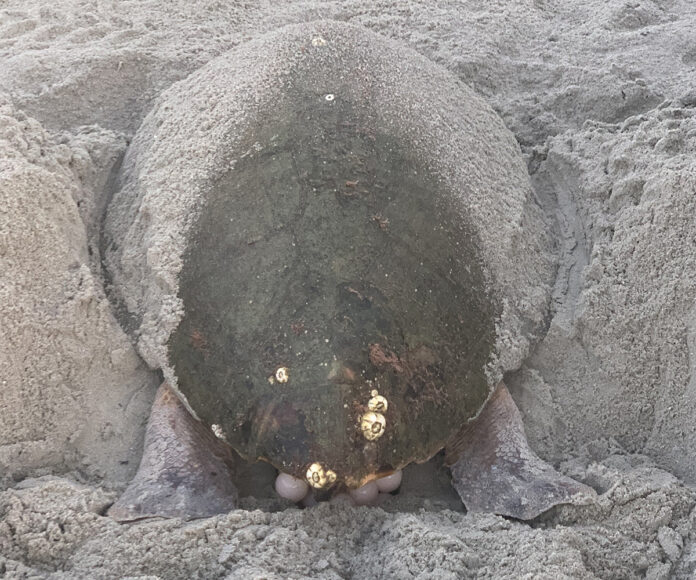
For hundreds of years, people have been drawn to the serene and steadfast nature of sea turtles. Included in folklore and revered by indigenous people, the mysterious creatures are studied around the globe.
After our family vacation in Frisco, North Carolina, I started a conversation with my girls about our favorite moments on the trip.
We agreed that one unusual morning was a treasured highlight of our week at the beach. I usually woke up early, made a cup of tea, and headed for the sand. I love the calmness and muted colors just after sunrise.
Telltale tracks
One morning, my sister-in-law was up even earlier than me for the first rays of the sunrise. Excitedly, she shared with me that she had seen tracks in the sand where a loggerhead turtle had laid eggs.
A female loggerhead leaves very distinct tracks in the sand when she leaves the ocean to lay her eggs. She crawls along with alternating flipper movement. Her dragging belly leaves a large center mark.
Another clue for identification is the lack of a tail mark. The width of the markings, on average, is 37 inches.
Just as my sister-in-law saw the tracks, turtle patrol was making their way down the beach. Turtle patrol acts as guardians of sea turtle eggs laid along the coast. They watch every morning during nesting season for tracks on the beach.
After identifying the type of turtle based on the tracks, they alert the park rangers. The area around the nest is marked off with posts and strings in hopes of keeping the area undisturbed. A small group of people had gathered around the marked-off area waiting for the park ranger.
I had joined my sister-in-law at this point, along with some of my kids. The park ranger arrived and explained the next steps in the process.
Protection process
Protected under the Endangered Species Act, loggerheads are in danger of extinction. First, the park ranger checked to see if the nest was far enough away from the water. Swimming to shore and climbing up the sand to lay eggs is exhausting for sea turtles. The new nest we were close to was far enough from the water.
Next, he put on gloves and gently dug into the sand. He was checking the depth of the nest and obtaining one egg for DNA testing.
We were intrigued by the appearance of the one egg. One of the kids said it was like a chicken egg after soaking in vinegar. It did not have a hard shell like a chicken’s egg. It was more like leather, but thin.

Since this nest did not need to be relocated for safety, the ranger did not count the eggs. He covered the nest again with sand and placed two separate markers near the nest. In case of high winds or hurricanes, one marker was placed high in the dunes. Another marker with a sensor was buried near the nest in the sand.
After recording the data and location, the ranger raked the sand back to its normal appearance. He informed us that the hatchlings would emerge from the nest in 45-55 days.
Dangerous life
The hatchlings follow the brightest light form, which is hopefully the reflection of the moon on the water. Their chance of survival is minuscule. It is thought that 1 in 1,000 reach maturity.
There are many dangers for hatchlings, including environmental and natural predators. Ingested plastic can be fatal for sea turtles. Their preferred food is jellyfish. Plastic bags look very similar to their favorite snack.
Loggerhead sea turtles can travel thousands of miles in sea currents. The younger years are called “lost years” because little is known about their location or activity.
A loggerhead is considered mature at the mating age of around 35 years. Then the cycle of life continues as a female will mate with several males before she migrates back to the same area where she was born.
One female loggerhead sea turtle can lay three to six hutches or nests of eggs, but on average usually four. Each hutch has about 100 eggs each. She lays the hutches 12-14 days apart in separate locations along the beach.
It is thought that the distance between the hutches is meant to ensure the survival of some of the eggs. If one hutch is attacked or disturbed, several other hutches from the same mother are located along the shore. The females lay eggs every 2-3 years.
The park ranger explained that using DNA from eggs, scientists were able to determine that three generations of loggerhead sea turtles were laying eggs on the same beach during one nesting season. That is quite the legacy of endurance, determination, and survival.
After the science lesson and up-close encounter, all the cousins now want to be marine biologists. We were thankful for the willingness of the park ranger to share his knowledge.
Armed with knowledge, we can make small changes to ensure the cycle continues of this amazing animal.












